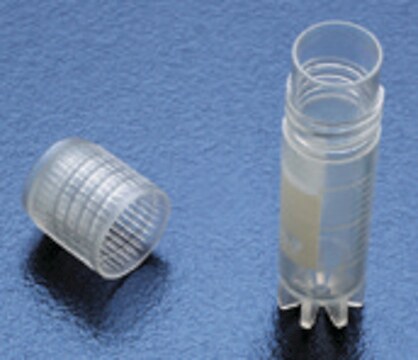V5007
Nalgene® cryogenic vials
capacity 2.0 mL, sterile, External threads
Synonym(s):
cryostorage vial, cryovial cryotube
About This Item
Recommended Products
material
colorless tube
conical bottom
high-density polyethylene closure
polypropylene
polypropylene tube
sterility
sterile
feature
External threads
packaging
package of 25 vials 20
pack of 500 ea (20 x 25 ea)
manufacturer/tradename
Nalgene® 5000-0020
parameter
-150 °C min. temp.
technique(s)
cryopreservation: suitable
capacity
2.0 mL
tube diam.
12.7 mm
Looking for similar products? Visit Product Comparison Guide
General description
Sterile vials and closures are pre-assembled and radiation-sterilized. A white marking area, fill line and graduations are printed on the side. Certified sterile, non-cytotoxic and non-pyrogenic.
Note: Do not use cryogenic vials for storage in the liquid phase of liquid nitrogen unless correctly sealed in Nunc CryoFlex™ tubing. Such use may cause entrapment of liquefied nitrogen inside the vial and lead to pressure build-up resulting in possible explosion or biohazard release.
Legal Information
Certificates of Analysis (COA)
Search for Certificates of Analysis (COA) by entering the products Lot/Batch Number. Lot and Batch Numbers can be found on a product’s label following the words ‘Lot’ or ‘Batch’.
Already Own This Product?
Find documentation for the products that you have recently purchased in the Document Library.
Customers Also Viewed
Our team of scientists has experience in all areas of research including Life Science, Material Science, Chemical Synthesis, Chromatography, Analytical and many others.
Contact Technical Service





